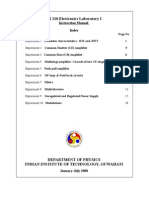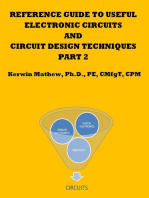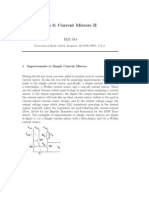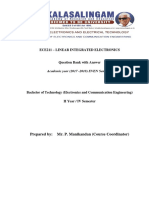ECD Lab 6
ECD Lab 6
Uploaded by
Rakhmeen gulCopyright:
Available Formats
ECD Lab 6
ECD Lab 6
Uploaded by
Rakhmeen gulOriginal Title
Copyright
Available Formats
Share this document
Did you find this document useful?
Is this content inappropriate?
Copyright:
Available Formats
ECD Lab 6
ECD Lab 6
Uploaded by
Rakhmeen gulCopyright:
Available Formats
Department of Electrical Engineering
Faculty Member: _ Dated : _
Semester: _______________ Section: ________________
EE313: ELECTRONIC CIRCUIT DESIGN
Lab 6: BJT Current Mirror Circuits
(Widlar Current Source)
Name Reg. No Viva Analysis Modern Ethics Individual
of data in Tool and and Team
Lab Usage Safety Work
Report
5 Marks 5 Marks 5 Marks 5 Marks 5 Marks
BJT Current Mirror Circuits
(Widlar Current Source)
EE313: Electronic Circuit Design Page 1
Introduction
1. This laboratory execise is meant to enble the students to design and understand the basic working of
current mirrors. For this, current mirrors with different configurations are implemented and the current
voltage relationships and output resistance of the circuits are studied thoroughly. In the end, a conclusion is
drawn on the basis of comparative study.
Objective
2. This laboratory will enable the students to achieve the following:
2.1. To design a Widlar Current Source
Conduct of Lab
3. The students have to perform this experiment using Pspice.Hardware implentation is also required.
4. The students are required to work in groups of three to four; each student must attempt to understand the
the use of a simple set up for measuring the parameters of the given transistor.In case some aspect of the
lab experiment is not understood the students are advised to seek help from the teacher, the lab
technicians or the Lab engineer.
Theory and Background
5. A current mirror is a circuit which can provide a copy of a current from a single reference current source to
one or more circuit elements which require current biasing. This allows for distribution from a single
reference by minimizing direct connections to the reference current source. In addition the current steering
circuits can be added to allow for the reference current to be distributed to many circuits that require
biasing constant currents.
6. The Widlar current source, shown in Figure 2, is a variant of the current mirror that includes a resistor
connected between the emitter of Q2 and ground. In this design, Re acts to reduce Vbe on Q2, which
reduces Ib and thus Ic.
7. The basic PSpice models and symbols are given in table-1. These will be used in the exercise.
Table-1: PSpice Symbols used in exercise
EE313: Electronic Circuit Design Page 2
PSpice Symbol PSpice Symbol
Name
Name
0 L1
1 2
10uH
L
R1 V1
1Vac
0V dc
R 1K Vac
For Frequency Response only
Q1
C1
1u
Q 2N 2222
C Q2N2222
V1 = 0 V3
V2 = 1
TD = 0 V1
TR = 1 n 5Vdc
TF = 1 n
P W = 20m
P E R = 40m
VPULSE VDC
For Bias Point and DC Sweep
For Transient Response only
Analysis
INSTRUCTIONS FOR LAB REPORT
This handout will be used as part of Lab Report which is to be submitted by each group. Wherever a
measurement value is to recorded, or a calculation has to annotate, it will be done in student’s own
handwriting.
The required curves and graphs that have been asked in the handout will be attached with this handout. It is
important that correct labeling of graphs is done and referred to in the appropriate place of the handout.
Wherever a question requires an explanation, it will be written in the students own handwriting.
The finished lab report will be given before the commencement of the next lab.
EE313: Electronic Circuit Design Page 3
PART 1 – Simple Current Mirror (Simulate Only)
R1
V1 V2
5V dc Q1 1V dc
Q 2N 2222
Q2
Q 2N 2222
0 0
Fig. 1: Simple Current Mirror
1. Simple Current Mirror
1.1. Calculate the value of resistor R1 to generate IREF equal to 1 mA.
R1 ____________________________
1.2. Now setup the circuit in PSPICE as shown in (Fig-1) and use the “Bias Point” analysis mode of PSpice
to show that the collector current in Q2 is nearly the same as IREF. In addition save the circuit by using
print screen option.
The percentage difference ___________________________
1.3. Now alter the voltage V2 as shown in following table and record the values of IO at Q2 :
V2 DC Supply 1V 2V 3V 4V 5V
IO at Q2
1.4. What would be the value of R1 in Fig. 1, if IO at Q2 is required to be 10 µA.
EE313: Electronic Circuit Design Page 4
PART 2 – The Widlar Current Source
R1
V1 I V2
5V dc 3V dc
Q1
0 0
Q 2N 2222
Q Q2
2
I
Q 2N 2222
R2
Fig. 2: Widlar Current Source
2. The WIDLAR Current Source
2.1. (a) Calculate the value of resistor R1 (figure-2) to generate IREF of 1 mA.
R1 ____________________________
2.2. What would be the value of R2 if IO at Q2 is required to be 10 uAmp?
R2____________________________
EE313: Electronic Circuit Design Page 5
2.3. Now setup the circuit in PSpice as shown in (Fig-2) and use the “Bias Point” analysis type to show
that the collector current in Q2 is nearly 10uAmperes. In addition save the DC bias voltage results by
using print screen option.
The percentage difference ___________________________
2.4. Comparing the value of resistance in section 2.2 and section 1.5, which approach is better to be
implemented from integrated circuit design point of view?
2.5. Now calculate the output resistance of the circuit. This can be done by selecting the “DC Sweep”
analysis type and sweeping the voltage V2 with Start Value=0, End Value=5 and Increment=0.01. The
output resistance is the slope of the IV-curve generated. In addition save the graph by using print
screen option.
Output Resistance___________________________
2.6. Now patch the circuit, as shown in (Fig-2), on Breadboard and verify your simulation results.
Note: You may have to use a Load resistance for practical part to avoid possible thermal runaway e.g. 1K
resistor at collector of Q2
Io=___________________________
The percentage difference ___________________________
2.7. Now alter the voltage V2 as shown in following table and record the values of IO at Q2 : Draw an I vs V
Graph.
V2 DC Supply 1V 2V 3V 4V 5V
IO at Q2
Now calculate the output resistance of the circuit. This can be done by calculating the slope of the I-V
graph in linear region and taking the inverse of slope.
Output Resistance___________________________
EE313: Electronic Circuit Design Page 6
You might also like
- Ec 2254 Linear Integrated CircuitsDocument376 pagesEc 2254 Linear Integrated CircuitsPavan Kumar100% (1)
- 6-ECD Lab 6 (1) Saad NadeemDocument8 pages6-ECD Lab 6 (1) Saad NadeemSaad NadeemNo ratings yet
- EDC Lab No.8 (BJT Common Emitter I-V Characteristics)Document5 pagesEDC Lab No.8 (BJT Common Emitter I-V Characteristics)Umair WaqasNo ratings yet
- ECD Lab 2Document6 pagesECD Lab 2Maryam MahmoodNo ratings yet
- Electronics Lab ExperimentDocument4 pagesElectronics Lab ExperimentWacko AsahanNo ratings yet
- SKEE 2742 Basic Electronics Lab: Experiment 2 BJT Small-Signal AmplifierDocument8 pagesSKEE 2742 Basic Electronics Lab: Experiment 2 BJT Small-Signal Amplifierمحمد ابو جرادNo ratings yet
- Mert Terzi 150718061 LabReport4Document8 pagesMert Terzi 150718061 LabReport4Mert TerziNo ratings yet
- 18ECL48 Lab ManualDocument66 pages18ECL48 Lab Manualsystech techniques100% (1)
- EE312 LabsDocument27 pagesEE312 LabsHaniDjekrifNo ratings yet
- ELET 211 Lab Manual 2022Document125 pagesELET 211 Lab Manual 2022Ahmad ManaNo ratings yet
- ECE - 304L - Lab - 8 - Square - Wave - Generation - 1Document2 pagesECE - 304L - Lab - 8 - Square - Wave - Generation - 1irfanNo ratings yet
- EOC3Document7 pagesEOC3Iman AthirahNo ratings yet
- Experiment 3 Lab ManualDocument5 pagesExperiment 3 Lab ManualutbdchannelNo ratings yet
- EDC Lab 10Document14 pagesEDC Lab 10uf73735No ratings yet
- BJT CompleteDocument9 pagesBJT CompleteMano EndlaNo ratings yet
- Zener LimiterDocument5 pagesZener LimitersameeNo ratings yet
- ENA Lab 11 PDFDocument6 pagesENA Lab 11 PDFZainab MansoorNo ratings yet
- Lab 03Document7 pagesLab 03Rehan BasharatNo ratings yet
- High Side Current Sense CircuitDocument6 pagesHigh Side Current Sense Circuitabhay pandeyNo ratings yet
- ECE321 - 6th EXPDocument4 pagesECE321 - 6th EXPمحمد ابراهيمNo ratings yet
- Universidad Politecnica Salesiana. Laboratorio Analogica: Practica 5: Análisis de Característica de Un Diodo A SilicioDocument3 pagesUniversidad Politecnica Salesiana. Laboratorio Analogica: Practica 5: Análisis de Característica de Un Diodo A SiliciojefersonNo ratings yet
- MEC 2009-Lecture 2 SwitchesDocument27 pagesMEC 2009-Lecture 2 SwitchesDennis BandaNo ratings yet
- Opto CouplerDocument9 pagesOpto CouplerPadmo PadmundonoNo ratings yet
- Lab 9 Common Emitter Amplifier: Department of Electrical EngineeringDocument7 pagesLab 9 Common Emitter Amplifier: Department of Electrical EngineeringKainat KhalidNo ratings yet
- Experiment Common Emitter AmplifierDocument3 pagesExperiment Common Emitter Amplifierيعقوب الحدادNo ratings yet
- Lab 02Document6 pagesLab 02Rehan BasharatNo ratings yet
- EDC Lab No.9 (BJT ApplicationsTransistor Switches-Security Alarm)Document4 pagesEDC Lab No.9 (BJT ApplicationsTransistor Switches-Security Alarm)sameeNo ratings yet
- 182 ECE110 Final ExamDocument4 pages182 ECE110 Final ExamPham Lê HuyNo ratings yet
- CAD Lab Manual KEC 653B (4mail)Document38 pagesCAD Lab Manual KEC 653B (4mail)Piyush0% (1)
- ECD Lab 2 PDFDocument12 pagesECD Lab 2 PDFMaryam MahmoodNo ratings yet
- Lab 2Document8 pagesLab 2Richard MillerNo ratings yet
- Laboratory Instruction Sheet: Jabatan Pendidikan Kejuruteraan Fakulti Pendidikan Teknikal Dan VokasionalDocument4 pagesLaboratory Instruction Sheet: Jabatan Pendidikan Kejuruteraan Fakulti Pendidikan Teknikal Dan VokasionalBlank BlankNo ratings yet
- BJT Switch Salman DaowdDocument5 pagesBJT Switch Salman Daowdosama.omt2002No ratings yet
- Lab #2 - DiodesDocument16 pagesLab #2 - DiodescrackintheshatNo ratings yet
- ECD Lab Report 07Document16 pagesECD Lab Report 07madnir99No ratings yet
- Report - Flashing LED ExperimentDocument6 pagesReport - Flashing LED ExperimentAnonymous rsxb6oEGpNo ratings yet
- Lab 6 BJT DC and Ac Analysis BBN 10205 (Done)Document6 pagesLab 6 BJT DC and Ac Analysis BBN 10205 (Done)Zhamir ZhakwanNo ratings yet
- Lab 8Document10 pagesLab 8Mike AlbertNo ratings yet
- Sample EC8461 Lab Manual & RecordDocument113 pagesSample EC8461 Lab Manual & RecordSHRI VARSHA R 19EC016No ratings yet
- SKEE 2742 Basic Electronic Lab: Experiment 1 Zener DiodeDocument5 pagesSKEE 2742 Basic Electronic Lab: Experiment 1 Zener Diodeمحمد ابو جرادNo ratings yet
- Lab 3Document4 pagesLab 3J SarduaNo ratings yet
- BEEE Experiment 2Document11 pagesBEEE Experiment 2Akash GolwalkarNo ratings yet
- PH210 Lab ManualDocument23 pagesPH210 Lab ManualAshish AgrawalNo ratings yet
- Electrical Simulation Lab Manual PDFDocument55 pagesElectrical Simulation Lab Manual PDFAnu tiwari0% (1)
- Session-10 Assignment Name: Dharmi Javiya Enroll No: 92100133058Document3 pagesSession-10 Assignment Name: Dharmi Javiya Enroll No: 92100133058Dharmi JaviyaNo ratings yet
- EPE423a Exper4Document9 pagesEPE423a Exper4Mohab ZationNo ratings yet
- Al-Balqa' Applied University: Electronics LabDocument54 pagesAl-Balqa' Applied University: Electronics Labahmad abufaresNo ratings yet
- Iwomi ElectDocument5 pagesIwomi ElectP1nice48No ratings yet
- EEN360: Electronics Circuits Lab Assignment 1 BJT Amplifiers Frequency RespondDocument6 pagesEEN360: Electronics Circuits Lab Assignment 1 BJT Amplifiers Frequency RespondMohammed ShifulNo ratings yet
- ELEG 220L Lab 2Document7 pagesELEG 220L Lab 2engrkumailabbasNo ratings yet
- Regulated Power SupplyDocument19 pagesRegulated Power SupplyRonn Albert GabucayNo ratings yet
- Lab 12: BJT Common Emitter Amplifier: 1. ObjectivesDocument4 pagesLab 12: BJT Common Emitter Amplifier: 1. ObjectivesAnuj MishraNo ratings yet
- Lab 12Document4 pagesLab 12Mert AçikelNo ratings yet
- ProblemsDocument1 pageProblemsGameplay OrIgInAlINo ratings yet
- ECA-Labmanual BookDocument56 pagesECA-Labmanual BookL Hari Venkatesh100% (2)
- Power Eectronics Lab Manual#09Document6 pagesPower Eectronics Lab Manual#09Muhammad Salman ShahidNo ratings yet
- Experiment No. 6 Op-Amp As Comparator & Schmitt Trigger: Analog Circuits LAB ManualDocument14 pagesExperiment No. 6 Op-Amp As Comparator & Schmitt Trigger: Analog Circuits LAB ManualchaitanyaNo ratings yet
- Experiment 3Document3 pagesExperiment 3ugurgul123No ratings yet
- Design of Electrical Circuits using Engineering Software ToolsFrom EverandDesign of Electrical Circuits using Engineering Software ToolsNo ratings yet
- Reference Guide To Useful Electronic Circuits And Circuit Design Techniques - Part 2From EverandReference Guide To Useful Electronic Circuits And Circuit Design Techniques - Part 2No ratings yet
- Lecture Slides - Week-02 Review of Signals PDFDocument30 pagesLecture Slides - Week-02 Review of Signals PDFRakhmeen gulNo ratings yet
- Lecture Slides - Week-03 Fourier Series and Fourier Transform PDFDocument31 pagesLecture Slides - Week-03 Fourier Series and Fourier Transform PDFRakhmeen gulNo ratings yet
- Lecture Slides - Week-06 Angle Modulation PDFDocument14 pagesLecture Slides - Week-06 Angle Modulation PDFRakhmeen gulNo ratings yet
- Lecture Slides - Week-05 SSB and VSB Modulation PDFDocument14 pagesLecture Slides - Week-05 SSB and VSB Modulation PDFRakhmeen gulNo ratings yet
- Lecture Slides - Week-04 DSB-SC and AM PDFDocument16 pagesLecture Slides - Week-04 DSB-SC and AM PDFRakhmeen gulNo ratings yet
- Lecture 04 PDFDocument18 pagesLecture 04 PDFRakhmeen gulNo ratings yet
- Lecture - 02 - 03 - Discrete Time Signals - 2.1-2.4 PDFDocument43 pagesLecture - 02 - 03 - Discrete Time Signals - 2.1-2.4 PDFRakhmeen gulNo ratings yet
- Chapter 4 Time Response of Dynamic Systems 1Document86 pagesChapter 4 Time Response of Dynamic Systems 1Rakhmeen gulNo ratings yet
- Lecture 05 Electromechanical Systems Transfer FunctionsDocument13 pagesLecture 05 Electromechanical Systems Transfer FunctionsRakhmeen gulNo ratings yet
- Chapter 7 Steady-State ErrorDocument53 pagesChapter 7 Steady-State ErrorRakhmeen gulNo ratings yet
- Lecture 06 Case Study - Antena Position ControlDocument15 pagesLecture 06 Case Study - Antena Position ControlRakhmeen gulNo ratings yet
- Chapter 5 Alternative Representation in State SpaceDocument13 pagesChapter 5 Alternative Representation in State SpaceRakhmeen gulNo ratings yet
- Lec 8 5 8 6BJT-Differential AmplifierDocument105 pagesLec 8 5 8 6BJT-Differential AmplifierRakhmeen gulNo ratings yet
- EEEB273 (Electronics Analysis & Design II) 5-08-2013: Self Check QuestionsDocument15 pagesEEEB273 (Electronics Analysis & Design II) 5-08-2013: Self Check QuestionsStephen Samuel Jr.No ratings yet
- Ec2254 NolDocument376 pagesEc2254 NolkumararguruNo ratings yet
- ECD Lab 6Document6 pagesECD Lab 6Rakhmeen gulNo ratings yet
- UntitledDocument171 pagesUntitledButter TeaNo ratings yet
- Linear Integrated Circuits - EC2254Document77 pagesLinear Integrated Circuits - EC2254Muthu LakiNo ratings yet
- EC8453 Linear Integrated CircuitsDocument55 pagesEC8453 Linear Integrated CircuitsSAYEM AHAMMEDNo ratings yet
- Lab 6Document5 pagesLab 6svijiNo ratings yet
- EC3451-LINEAR INTEGRATED CIRCUITS-2146226120-LIC QBDocument12 pagesEC3451-LINEAR INTEGRATED CIRCUITS-2146226120-LIC QBSanjayrajNo ratings yet
- Chap8 LectureDocument64 pagesChap8 LectureJanko JaridicNo ratings yet
- Dechassa - Retta - Lemma - 3189815 - 22577354 - BEE 332# Due Nov 2 From Abraham.aDocument33 pagesDechassa - Retta - Lemma - 3189815 - 22577354 - BEE 332# Due Nov 2 From Abraham.ajoe.kurina3194No ratings yet
- LIC Question BankDocument7 pagesLIC Question BankParvathy S ParvathyNo ratings yet
- LIC All Unit Q&ADocument22 pagesLIC All Unit Q&AG.MUNEER BABA,EEE18 Vel Tech, ChennaiNo ratings yet
- Wilson Current Sourc1Document4 pagesWilson Current Sourc1prinxesparrowNo ratings yet
- Ic 2Document30 pagesIc 2Radhie NoahNo ratings yet
- EC8453-Linear Integrated Circuits Department of ECE 2018-19Document26 pagesEC8453-Linear Integrated Circuits Department of ECE 2018-19senNo ratings yet
- EC6404 Uw PDFDocument354 pagesEC6404 Uw PDFIrfan AzadNo ratings yet
- Chapter - 2 Circuit Configurations For Linear Ics - Contd.: DRVSKBDocument7 pagesChapter - 2 Circuit Configurations For Linear Ics - Contd.: DRVSKBnithyaskrishnanNo ratings yet
- Ec8453-Linear Integrated Circuits-1451692048-Lic Notes Ec8453Document131 pagesEc8453-Linear Integrated Circuits-1451692048-Lic Notes Ec8453Dr.T.sivakami biherNo ratings yet
- Karpagam College of Engineering: Coimbatore-32Document2 pagesKarpagam College of Engineering: Coimbatore-32D Geetha DuraiNo ratings yet
- ECE211 Question Bank With AnswerDocument101 pagesECE211 Question Bank With Answermaanip85No ratings yet
- Integrated CircuitDocument160 pagesIntegrated Circuitpcjoshi02No ratings yet
- EC 6404 Linear Integrated CircuitsDocument202 pagesEC 6404 Linear Integrated CircuitsVasanthNo ratings yet
- Ejercicios de MOSFETDocument5 pagesEjercicios de MOSFETLuis Enrique GarcíaNo ratings yet
- Ec2254Document375 pagesEc2254mohanNo ratings yet
- Quiz 8 - Attempt ReviewDocument3 pagesQuiz 8 - Attempt Reviewmajedcapiyoc.qcNo ratings yet
- Lic Solution 2Document26 pagesLic Solution 2Muiz TankiNo ratings yet
- EC2254 UwDocument376 pagesEC2254 UwHari vNo ratings yet
- 2 Marks Ldica NotesDocument8 pages2 Marks Ldica NotesRAJOLI GIRISAI MADHAV100% (2)
- Current MirrorsDocument76 pagesCurrent MirrorsSHRIDHAR N100% (1)






































































































